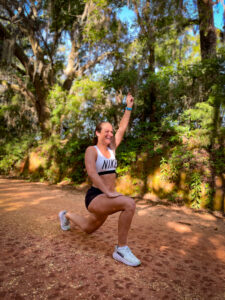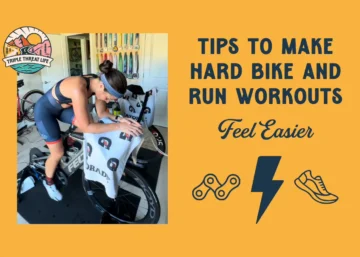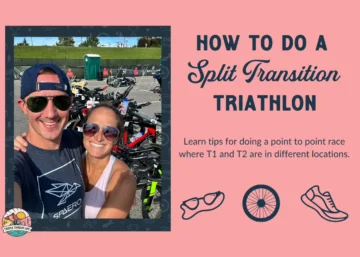With my job, I have the opportunity to chat with the coolest people: everyone from pro triathletes and elite trail runners to top coaches and age groupers.
During these interviews, we first go over all the questions for whatever article I’m working on, but then conversation shifts to talk of life, sport, life imitating sport, bikes, upcoming races, shoes, favorite snacks, and there’s inevitably a few “off the record” moments.
Sadly, you never get to see any of it. It just sits on my laptop, destined never to see the light of day… until now! (well, except for the off the record bits.)
Introducing The Cool Down– a blog series that will serve as a continuation of these interesting conversations.
It’s what happens when the work for the day is done and you get to chill out, chat with your friends, and enjoy a post-workout snack.
It’s the bonus content, fascinating stories, and juicy tidbits I’ve gathered from chatting with some of the most fascinating characters in the world of endurance sport.
First up is Neal Palles, an ultrarunning coach, psychotherapist, mental performance consultant, social worker… the list goes on, really. I talked to Neal and his colleague, Jim Rutberg, for an article that was recently published in Triathlete Magazine about the peak end rule.
The peak end rule is a fascinating bit of psychology that explains how our memory of an experience might be just as important as the experience itself. It shows how the most intense moments of an experience (the peaks) and the end of the experience (the end) can have a significant impact on our perception of an event, like a workout or a race.
Neal is a super insightful guy and after we’d finished talking about the peak-end rule, we quickly moved on to different topics: being a mindful athlete, how to create a positive head space, and refocusing when things get tough.
So, without further adieu, here’s The Cool Down with Neal Palles.
My coach has been trying to get me to mediate for probably the past two years. (I should really download that Headspace app she’s always telling me about). But for someone with a busy mind, like me, the act of meditation seems overwhelming.
 But a subset of meditation is mindfulness, which is something I work on every day, especially during training rides or runs. Being mindful and staying in the present moment, whether I’m on the bike trainer or in a race, can be challenging. I tend to get distracted, so anything that brings me back to the present moment is a great benefit, both as an athlete and in my daily life.
But a subset of meditation is mindfulness, which is something I work on every day, especially during training rides or runs. Being mindful and staying in the present moment, whether I’m on the bike trainer or in a race, can be challenging. I tend to get distracted, so anything that brings me back to the present moment is a great benefit, both as an athlete and in my daily life.
Palles explains that mindfulness is just one part of the pyramid of human motivation. “The thing is, it takes a lot of practice to be able to do that while swimming, biking and running, so you have to start out really basic.”
Palles says we can create opportunities to be mindful during a race, which is very helpful in a long distance event, like an IRONMAN, or the race Palles is currently training for- The Leadville 100.
His tip: Focus on your breathing.
“You’ve got control of your breath for an entire race, and that’s something you can anchor with and use to come back to your senses,” he says. “When you’re swimming, notice every time you come up for breath. Notice the water around you, the temperature, and how it feels. On the bike, notice the wind and listen to the sound of your wheels. See the clouds passing over head and listen to the people cheering you on during the run.”
If you get easily distracted or overwhelmed during a race, take a moment to focus on your breath and connect to something outside of your body.
“Now you’ve got a window of opportunity,” he says. “You can take a second to think, ‘What are my goals? How can I move forward in a direction toward those goals and aspirations?’”
Palles shared this great analogy where mindfulness is like a bright light that shines on everything, whereas focus is a spotlight that you can move and direct to specific areas.
“With planning and pre-practice, you can move that spotlight a bit. You can think, At what point in the race do I need to direct my focus, and where? Maybe it’s on nutrition, hydration, or pacing strategy.”

Maslow’s hierarchy of needs, (Wiki, 2023)
Do you remember your college psychology class when the professor talked about Maslow’s hierarchy of needs? It’s basically a theory that describes human motivation.
Picture a pyramid. At the bottom are base physiological needs like air, water, food, and shelter. Next is safety, followed by love and belonging, self-esteem, and finally self-actualization.
The theory is that the basic needs for survival (food, water, shelter) must be met before a person can focus on satisfying higher level needs (fulfilling a goal or living up to your potential). Palles explains this is one of the reasons why competing in an event like an IRONMAN is so hard.
“There are these basement level needs, like we’re in pain and we want food,” he says. “We need all that basic stuff while we’re trying to do an activity that’s self-actualization. We don’t need to do an IRONMAN, but we’re doing it for some higher level need. But, we have all basic needs screaming at us to pay attention to them, so how do we deal with that?”
With mindfulness, acceptance, and self-compassion.
“There’s almost a period of acceptance where you take a deep breath and refocus on the things you can control right now,” he says. “Our brains have a tendency to want to avoid things. You need to be able to notice when your focus is shifting way from where you want to go.”
 “You know it hurts and it’s going to be uncomfortable, but it might also mean you need to slow your pace down or eat and drink something. Know this is normal and you’re going to experience it. Recognize it, accept it, and refocus on the things you can control.”
“You know it hurts and it’s going to be uncomfortable, but it might also mean you need to slow your pace down or eat and drink something. Know this is normal and you’re going to experience it. Recognize it, accept it, and refocus on the things you can control.”
As you build up in your mindfulness practice, you can then incorporate it into meditation. “It can be a walking meditation or a running meditation,” he says. “The purpose is to notice thoughts, emotions, and sensations in a non judgmental, way while recognizing that you’re going to be judgmental about it, and that’s part of it.”


